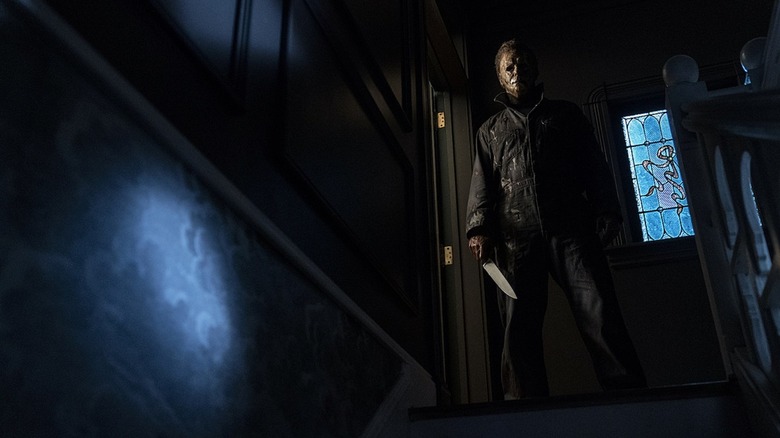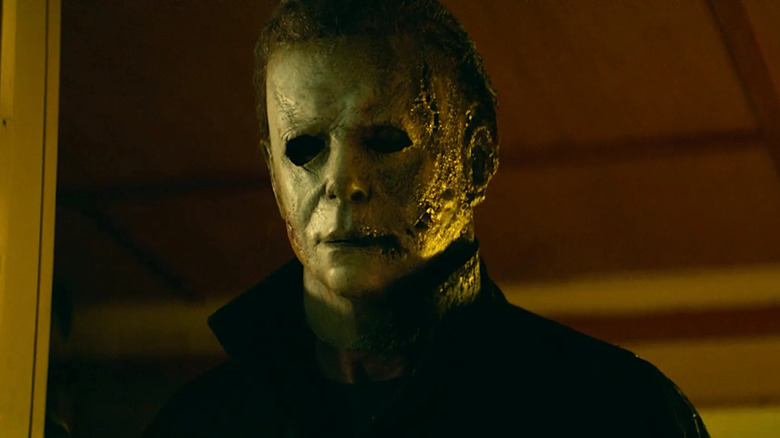Halloween Kills Was Shot With 'Brutal Camera Logic' And Hit The Crew Hard
John Carpenter, perhaps true to his name, is a workmanlike director. He doesn't possess any outwardly striking, signature aesthetic habits or camera tricks that one may call "Carpenterian." However, he still possesses a subtle mastery of the craft that is uniquely his. He simply knows where to place a camera to most effectively get a shot, shoots it, and moves on. He is practical with no pretenses toward being an artist. This is the man who, at a horror convention, was once asked how he felt about other filmmakers remaking his movies and running the risk of tainting his original artistic vision. Carpenter said that he actually loves it when others remake his movies because he gets money without having to work. His philosophy to remakes is one of "pay me."
In Abbie Bernstein's new book "Halloween: The Official Making of Halloween, Halloween Kills, and Halloween Ends," the authors explain that director David Gordon Green adopted a similar spartan — although perhaps less financially mercenary — philosophy when making his 2021 film "Halloween Kills," the second direct sequel to Carpenter's "Halloween" in a new, rebooted timeline. That film takes place mostly over the course of a single night, and there are many scenes of characters and crowds traversing the streets of Haddonfield, Illinois in the dark, searching for the vicious killer Michael Myers (James Jude Courtney).
In order to shoot these scenes, cinematographer Michael Simmonds had to arrange the lighting for "Kills" to match what the camera demanded, and not necessarily what the actors demanded. In a film with a large ensemble and with so many crowd scenes, Simmonds set the camera back, lit the space appropriately, and didn't take individual actors into consideration. This technique saved a lot of time, and ultimately made everything a little brighter.
Shooting at night
Despite the bright lighting, shooting at night more or less forced the "Halloween Kills" crew to become nocturnal. The film's assistant director Atilla Salih Yücer (also a second unit director and co-producer), said that the shoot was "relentless." Yücer noted something that anyone who works late at night will be able to attest; the hours can be brutal and mind-altering. He said "The first five weeks of that film was full nights. Do you know what that does to people? [...] Your body and your mind are completely rewired."
Needing to save time on setting up lighting rigs, likely to spare the crew, cinematographer Simmonds declared his bare-bones, Carpenterian view of getting the shots he needed. Simmonds said he adhered to a "brutal camera logic, not taking into consideration anything else aside from what makes sense for camera and lighting." He didn't need his actors to look a certain way in close-up. He just needed to get everyone lit. He would then use digital image correction after the shoot to make the film gloomier and more horror-like. This logical approach, Simmonds admitted, was more practical than artistic.
"[It was] not ideal from a certain perspective, but we needed to favor the light to accomplish all of our ambitions. This movie was a lot more logistically challenging than most because almost every scene is an ensemble scene, you have to cover everybody, every scene has stunts, or visual effects, or special effects, or pyrotechnics. I shot this brighter than [2018's] 'Halloween,' with the intent to make it darker in post. I wanted to make sure the audience could see the things they wanted to see."
One may criticize the script for "Halloween Kills," but one cannot deny that the photography is first-rate.

